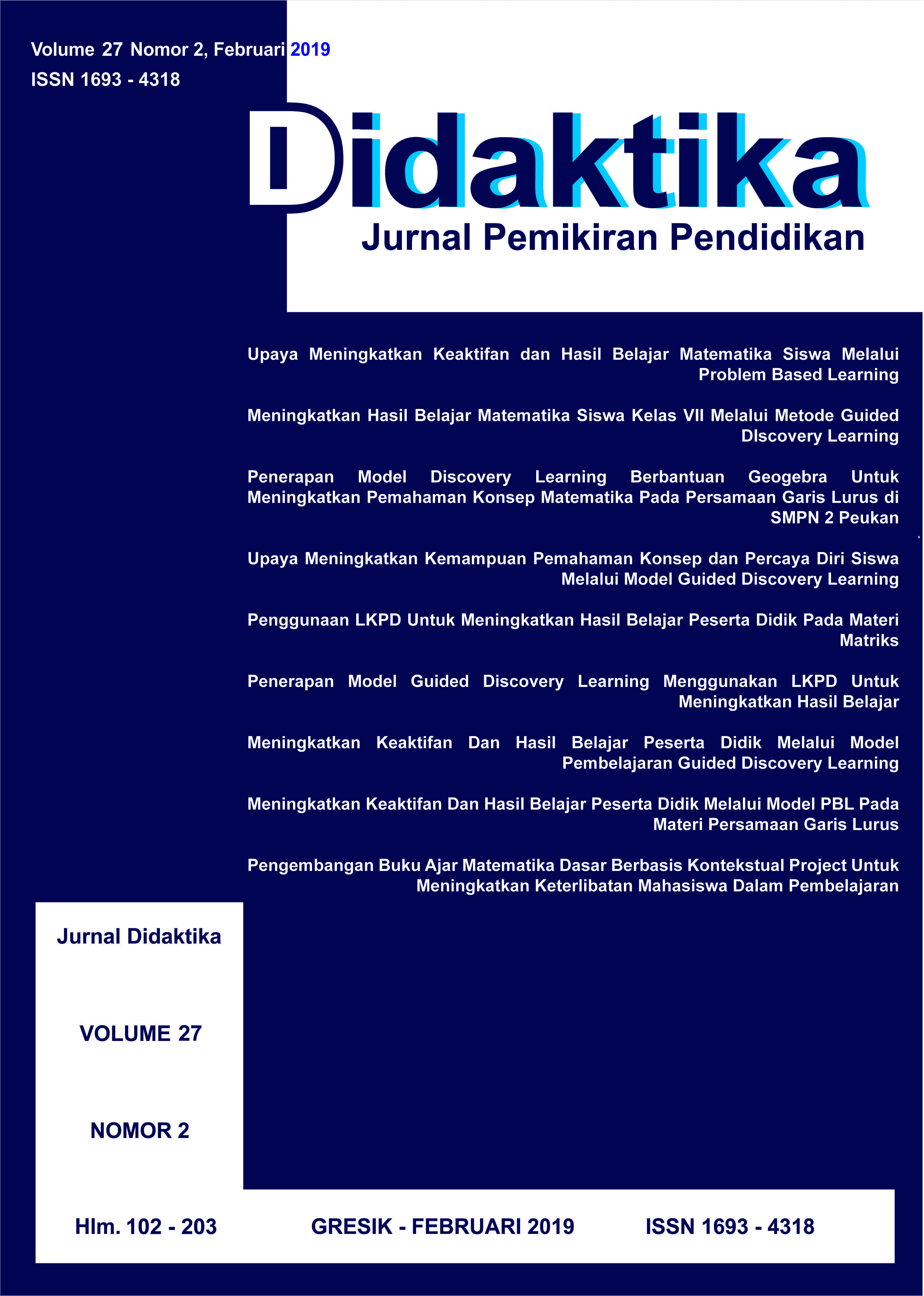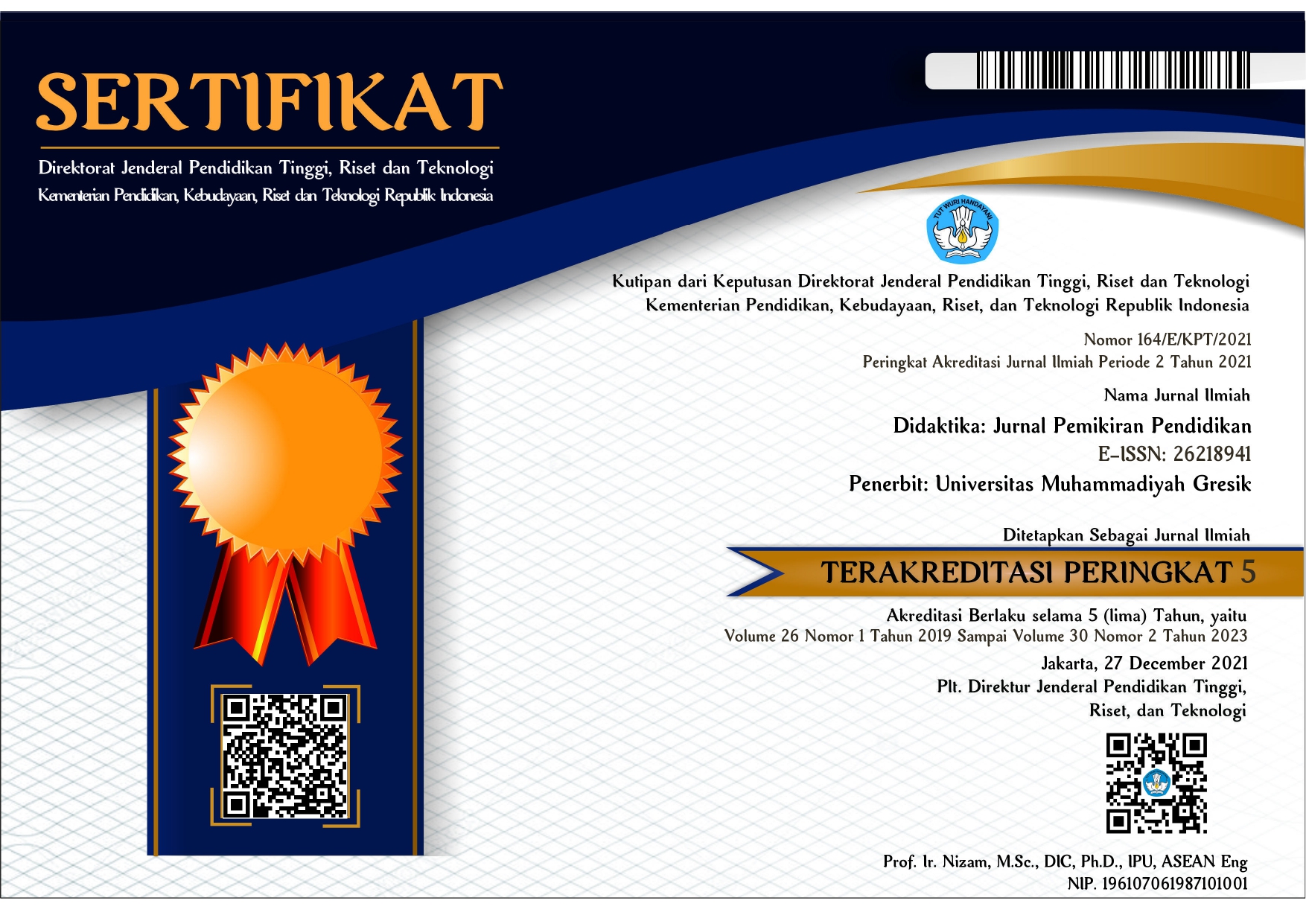Penerapan Model Guided Discovery Learning Menggunakan LKPD Untuk Meningkatkan Hasil Belajar
DOI:
https://doi.org/10.30587/didaktika.v27i2.2263Keywords:
hasil belajar, model guided discovery learningAbstract
Banyak faktor yang menyebabkan peserta didik kurang semangat dalam belajar. Hal ini menyebabkan daya tangkap siswa menjadi rendah serta kesulitan dalam menyelesaikan permasalahan dalam kehidupan sehari-hari. Hal ini tentu tidak boleh dibiarkan begitu saja, perlu adanya tindakan untuk mengatasinya. Salah satunya guru harus mampu melakukan proses pembelajaran dengan baik, bermakna bahkan melakukan inovasi. Ada berbagai cara untuk melakukan inovasi dalam pendidikan, misalnya saja dengan menerapkan model, media, metode, strategi, bahkan pendekatan pembelajaran yang bertujuan agar pembelajaran lebih menarik dan tidak terasa membosankan bagi peserta didik. Oleh karena itu peneliti bertujuan meningkatkan hasil belajar siswa dengan menerapkan model pembelajaran guided discovery learning menggunakan LKPD. Penelitian tindakan kelas ini menggunakan 16 peserta didik sebagai subjek penelitian. Hasil belajar diukur dengan menggunakan alat evaluasi. Datanya dianalisis menggunakan perhitungan persentase. Hasil penelitian menunjukkan adanya peningkatan hasil belajar peserta didik setelah implementasi model pembelajaran guided discovery learning menggunakan LKPD. Hal ini terlihat pada siklus I persentase peserta didik yang tuntas hanya 37,5 % dan naik pada siklus II menjadi 100%. Maka dapat disimpulkan bahwa penerapan model pembelajaran Guided Discovery Learning dapat meningkatkan hasil belajar peserta didik sehingga guru disarankan untuk menerapkan model Guided Discovery Learning.
Downloads
Published
How to Cite
Issue
Section
License
License and Copyright Agreement
In submitting the manuscript to the journal, the authors certify that:
- They are authorized by their co-authors to enter into these arrangements.
- The work described has not been formally published before, except in the form of an abstract or as part of a published lecture, review, thesis, or overlay journal.
- That it is not under consideration for publication elsewhere,
- That its publication has been approved by all the author(s) and by the responsible authorities – tacitly or explicitly – of the institutes where the work has been carried out.
- They secure the right to reproduce any material that has already been published or copyrighted elsewhere.
- They agree to the following license and copyright agreement.
Copyright
Authors who publish with DIDAKTIKA: Jurnal Pemikiran Pendidikan agree to the following terms:
- Authors retain copyright and grant the journal right of first publication with the work simultaneously licensed under a Creative Commons Attribution License (CC BY-SA 4.0) that allows others to share the work with an acknowledgment of the work's authorship and initial publication in this journal.
- Authors are able to enter into separate, additional contractual arrangements for the non-exclusive distribution of the journal's published version of the work (e.g., post it to an institutional repository or publish it in a book), with an acknowledgment of its initial publication in this journal.
- Authors are permitted and encouraged to post their work online (e.g., in institutional repositories or on their website) prior to and during the submission process, as it can lead to productive exchanges, as well as earlier and greater citation of published work.
Licensing for Data Publication
Open Data and Software Publishing and Sharing
The journal strives to maximize the replicability of the research published in it. Authors are thus required to share all data, code or protocols underlying the research reported in their articles. Exceptions are permitted but have to be justified in a written public statement accompanying the article.
Datasets and software should be deposited and permanently archived inappropriate, trusted, general, or domain-specific repositories (please consult http://service.re3data.org and/or software repositories such as GitHub, GitLab, Bioinformatics.org, or equivalent). The associated persistent identifiers (e.g. DOI, or others) of the dataset(s) must be included in the data or software resources section of the article. Reference(s) to datasets and software should also be included in the reference list of the article with DOIs (where available). Where no domain-specific data repository exists, authors should deposit their datasets in a general repository such as ZENODO, Dryad, Dataverse, or others.
Small data may also be published as data files or packages supplementary to a research article, however, the authors should prefer in all cases a deposition in data repositories.











